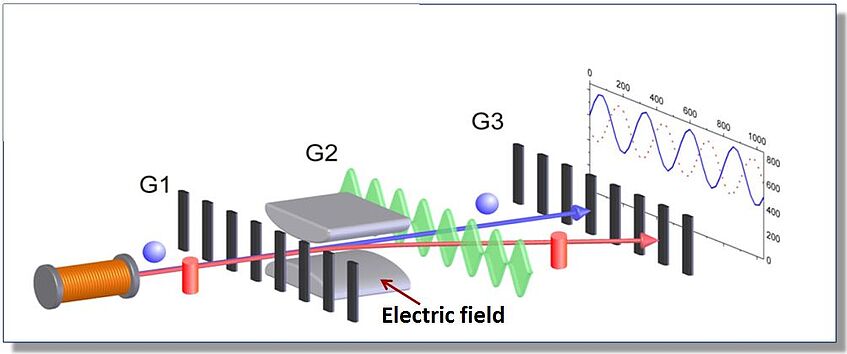Quantum-Interference -Assisted Metrology

Molecule interferometry shares with atom interferometry the potential of detecting miniscule forces using the same underlying principles, which we exemplify for the specific case of our various Talbot-Lau interferometers:
- Quantum interference in every of our devices (TLI/KDTLI/OTIMA/LUMI) imprints a nanoscale density pattern onto the molecular beam. It thus prepares a nano-scale material ruler in a highly isolated environment in ultra-high vacuum.
- External potentials or particles may interact with or be emitted by the delocalized molecules inside the interferometer. This inevitably results in momentum exchange and either a shift of the fringe pattern - if the momentum transfer is the same for all molecules - or a reduction of the fringe contrast - if different molecules receive momentum kicks of different strength or direction.
- Reading the fringe shift or fringe contrast, provides a sensitive measure either for the external forces and fields or for internal particle properties, in case the external perturbations are well characterized.
Modern atom interferometry has been mostly developed into a tool for inertial force sensing with stunning precision that can quantify accelerations to nine digits precision, even commercially. This high sensitivity is mostly due to the very high signal-to-noise that became possible because of laser cooling and Bose Einstein condensation.
Achieving a similar sensitivity for proteins, DNA, or complex clusters is still one of the grand open challenges for future research. However, we also note that certain properties are not even defined with this precision by nature itself. Warm molecules may undergo internal state changes on the nanosecond scale. This is why measurements on the permille scale are not only urgently required but also fully sufficient.
The internal molecular complexity of mesoscopic particles exceeds that of atoms by orders of magnitude and elucidating the internal properties of large molecules is an important challenge that can be very well addressed in molecule interferometry. We can in particular learn about
- Electrical properties, such as polarizabilities, dipole moments
- Optical properties, such as absolute absorption cross sections, and later also excited state dynamics
- Structural features and their dynamical change: indirectly through their influences on the electrical, optical and magnetic features
- Magnetic properties: dipole moments and magnetic susceptibility
Now, consider a matter-wave interferometer composed of three beam splitters: shifting one of the beam splitters transverse to the particle beam by Δxi also displaces the interference fringes in a Talbot-Lau device by Δxfringe=Δx1-2Δx1+Δx3.
In the presence of a constant external acceleration a such as
- Gravity: a=g
- Coriolis force: a=2v×ω
- External electric field E acting on a particle of polarizability α: a=αE(∇E)/2m
one may transform into the molecular reference system and regard the gratings (rather than the molecule) as free falling. In this case the shift of every grating with time T is: Δxi= a T2/2 and the resulting fringe displacement at the end of the interferometer is Δxfringe= aT2. It grows quadratically with the coherent evolution time T between the gratings, but also linearly in the acceleration a, which may grow with molecular size.
Matter-wave interferometry bears the potential of knowing all these electro/magnetic/optical/structural properties for many complex molecules and nanoparticles, isolated or in tailored environments, with substantially improved precision because of the high intrinsic spatial resolution of the interferogram. This shall allow us to contribute to future benchmarks of physical chemistry, computational chemistry and biomolecular chemistry.
References
- Lukas Mairhofer, Sandra Eibenberger, Joseph P. Cotter, Marion Romirer, A. Shayeghi, and Markus Arndt
Quantum-assisted metrology of neutral vitamins in the gas-phase
Angew. Chem. Int. Ed. 56, 1-6 (2017), DOI: 10.1002/anie.201704916 - Sandra Eibenberger, Xiaxi Cheng, J.P. Cotter, Markus Arndt
Absolute absorption cross sections from photon recoil in a matter-wave interferometer
Phys. Rev. Lett. 112, 250402 (2014) - S. Eibenberger, S. Gerlich, M. Arndt, J. Tüxen and M. Mayor
Electric moments in molecule interferometry
New J. Phys. 13, 043033 (2011) - M. Gring, S. Gerlich, S. Eibenberger, S. Nimmrichter, T. Berrada, M. Arndt,H. Ulbricht, K. Hornberger, M. Müri, M. Mayor, M. Boeckmann and N. Doltsinis
Influence of conformational molecular dynamics on matter wave interferometry
Phys. Rev. A 81, 031604(R) (2010) - J. Tüxen, S. Gerlich, S. Eibenberger, M. Arndt and M. Mayor
Quantum interference distinguishes between constitutional isomers
Chem. Comm. 46, 4145 -4147 (2010) - S. Gerlich, M. Gring, H. Ulbricht, K. Hornberger, J. Tüxen, M. Mayor and M. Arndt
Matter-Wave Metrology as a Complementary Tool for Mass Spectrometry
Angew. Chem. Int. Ed. 47, 6195 -6198, (2008) - L. Hackermüller, K. Hornberger, S. Gerlich, M. Gring, H. Ulbricht and M. Arndt
Optical polarizabilities of large molecules measured in near ‐ field interferometryAppl. Phys. B 89 , 469 - 473 (2007)
